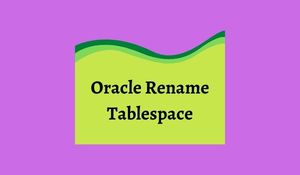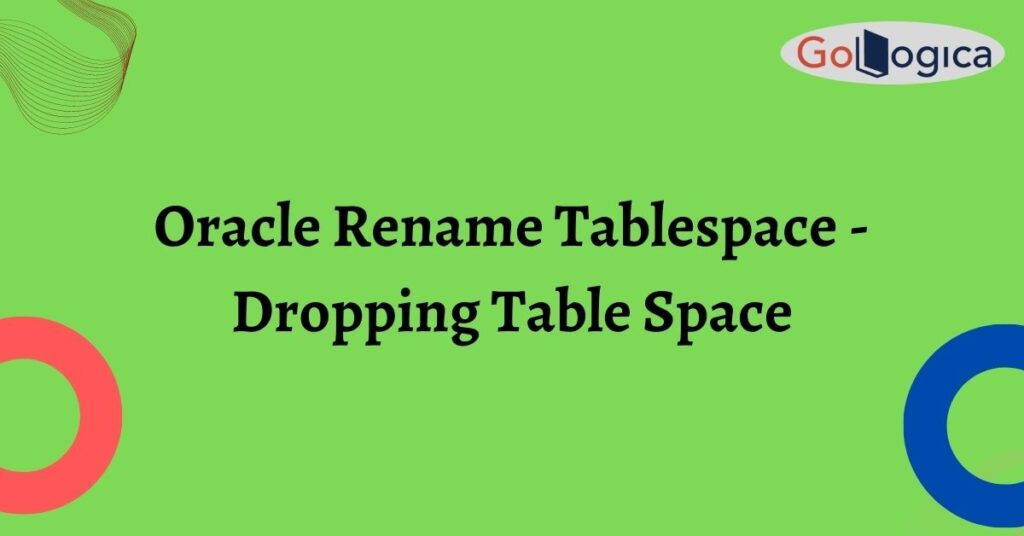
Introduction:
If you have ever needed to rename a tablespace in Oracle, you know that it can be a bit of a pain. You have to use the DROP TABLESPACE statement to drop the old tablespace and create a new one with the same name. However, there is a way to make this process much easier – using the Oracle Rename Tablespace command. This article will show you how to use this command to rename your tablespaces quickly and easily. Let’s get started!
Oracle provides the ability to rename a tablespace using the RENAME TABLESPACE command. This can be useful when you want to change the name of a tablespace for cosmetic reasons or when you want to move all of the objects from one tablespace to another.
However, there is one important thing to keep in mind when renaming a tablespace: the tablespace must be empty before you can rename it. If there are any objects in the tablespace, you will receive an error message.
To drop a tablespace, use the DROP TABLESPACE command. This will delete all of the objects in the tablespace, including data files and control files. Be very careful when using this command – there is no undo! Ensure that you have a backup of your data before dropping a tablespace.
In addition, if you are dropping a tablespace that is used by another schema, you must drop the schema first. Otherwise, you will receive an error message.
The following example shows how to drop a tablespace:
DROP TABLESPACE myts:
This command will delete the tablespace named myths, including all of the data files and control files. Remember that there is no undo, so be very careful when using this command!
Oracle provides the ability to rename a tablespace using the RENAME TABLESPACE command. This can be useful when you want to change the name of a tablespace for cosmetic reasons or when you want to move all of the objects from one tablespace to another.
However, there is one important thing to keep in mind when renaming a tablespace: the tablespace must be empty before you can rename it. If there are any objects in the tablespace, you will receive an error message.
To drop an Oracle tablespace, use the DROP TABLESPACE command. This will delete all of the objects in the tablespace, including data files and control files. Be very careful when using this command – there is no undo! Make sure that you have a backup of your data before dropping a tablespace.
In addition, if you are dropping a tablespace that is used by another schema, you must drop the schema first. Otherwise, you will receive an error message.
The following example shows how to drop a tablespace:
DROP TABLESPACE myts cascade;
This command will delete the tablespace named myths, including all of the data files and control files. It will also delete any other tablespaces that are dependent on myths. Remember that there is no undo, so be very careful when using this command!
Oracle Rename Tablespace
If you need to rename a tablespace in Oracle, there are a few steps you’ll need to take. First, make sure the tablespace is not currently in use – if it is, the rename will fail. Then, use the ALTER TABLESPACE statement to rename the tablespace:
ALTER TABLESPACE <tablespace_name> RENAME TO <new_tablespace_name>;
After renaming the tablespace, you’ll need to update any references to it in your schema objects and data files. Finally, drop the old tablespace using the DROP TABLESPACE statement:
DROP TABLESPACE <old_tablespace_name>;
That’s all there is to it!
Read Also: Complete Guide on Oracle Workflow Training
What is Oracle Tablespace?
Oracle tablespace is a container for database objects. It stores all the data and metadata for an object, such as tables, indexes, and triggers. A tablespace can be physically stored on a disk or in memory. When you create a table, you must specify a tablespace for it to reside. You can also move a table from one tablespace to another.
Tablespaces are divided into two categories: data files and temp files. Data files store the actual data, while temp files store temporary data. Oracle creates new temp files automatically whenever you need one. You can use the SQL command CREATE TEMPORARY TABLESPACE to create temp files specifically for storing temporary tables.
You can use the ALTER TABLESPACE command to change the characteristics of a tablespace, such as the amount of storage space it uses or the location of its data files. You can also use the command to move a table from one tablespace to another.
The following are some important things to keep in mind when working with tablespaces:
– A tablespace must be associated with a database.
– One user can only use tablespaces at a time.
– A table cannot span multiple tablespaces.
– A table cannot reside in memory and on disk simultaneously. If you want a table to reside in memory, you must place it in the INMEMORY clause of the CREATE TABLE statement.
– You can move a table from one tablespace to another, but you cannot move a table from disk to memory or vice versa.
– A tablespace can contain any object, including tables, indexes, clusters, and materialized views.
– A tablespace can be used to store both user data and system data. System data is data that is required by the database instance but is not owned by any specific user. For example, the data dictionary is system data.
– The data files in a tablespace can be spread across multiple disks.
– You can use the SQL command SHOW TABLESPACES to view a list of all the tablespaces in the database.
– You can use the SQL command CREATE TABLESPACE to create a new tablespace.
– The maximum size for a tablespace is 32 terabytes.
End of content background information.
Oracle tablespace is an important part of an Oracle database. It stores all the data and metadata for an object, such as tables, indexes, and triggers. A tablespace can be physically stored on a disk or in memory. When you create a table, you must specify a tablespace for it to reside. You can also move a table from one tablespace to another.
Conclusion:
If you are looking to rename a tablespace or drop an existing tablespace, please consult with your database administrator before taking any action. They will be able to help you through the process and ensure that everything goes smoothly.
Related Courses
| Course Name | Enroll Now |
|---|---|
| Oracle Fusion HCM Cloud Training | Enroll Now |
| Oracle SCM Training | Enroll Now |
| Oracle Fusion Project Portfolio Management (PPM) Training | Enroll Now |
| ORACLE PL/SQL TRAINING | Enroll Now |
| ORACLE SQL TRAINING | Enroll Now |
Author Bio:
Anji Velagana loves pursuing excellence through writing. He currently writes for Gologica.com, a global leader in providing the best online training to individuals who wish to take training on different abilities. He has experience of 5 years in the field of content writing. Contact him via LinkedIn.



